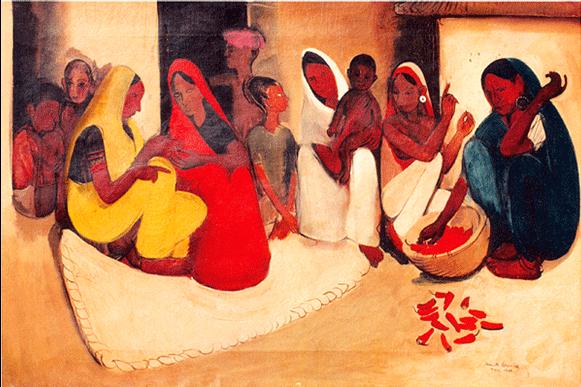 |
|
Amrita Sher-Gil had a great artistic connection with Hungary. She had developed a great passion for the paintings done by Brueghel.
Amrita had taken
some of the paintings of Brueghel as inspiration for her paintings, too. These
paintings made with such impressions were meant to be for the Hungarian market,
perhaps.
While living in Hungary, Amrita
Sher-Gil was used to work on larger canvases. The forms she depicted in her
paintings were simple in nature and larger in size, matching the area of canvases.
There are artists who come as the birds of passage, dip their wings into the beauty of colours and then fly away to the land of fame. Amrita-Sher-Gil ( 1913 - 1941 ) was such a beautiful bird who visited the land of art for a short period and sang delightful songs on her canvases.
She would paint in daylight. Perhaps she disliked the happening of uploading the colours on canvas and the presence of artificial light. Painting the Indian women at work, especially the women and girls living were her preferred subject. In any case, she would not allow anyone to look at her painting before it is completed. The name of this artist was Amrita Sher-Gill
Indian Art: In India, The Bengal school of artists has done a
revolution in the field of arts and culture. It helped to reshape the modern
taste among the Indian people in general and the Artists in particular.
The movement in the modern art sector made Indian artists aware of their own heritage. Amrita Sher-Gil’s paintings help to make the modern Indian painting a talk of the international art market.
 |
| Self Portrait Amrita Sher-Gil |
The Artist: Amrita Sher-Gil was a child
of the cross country marriage, Indian father and Hungarian mother. Born
in Hungary, she had the opportunity to paint European landscapes at
an early age. While studying art in Paris, she drew inspiration from the art of Paul Cezanne and Paul
Gauguin. Perhaps, her alter-ego, to be felt as being an India girl, was to
spring out in future. She portrayed an India woman, in a manner as if she
wanted to relive his life through the women she painted.
The
Subjects: On returning to India she painted the
subjects lying on the Indian landscape. Amrita Sher-Gil, though initially
inspired by the Post Impressionists, painted canvasses depicting the life of
the ordinary people of India. Women living in the hill area
of Northern India was her favourite subject.
In such a costume and appearance,
she would make her studio looking more austere and painterly. And with her hair
pulled tightly back, she completed the stark and austere atmosphere which
prevailed in her studio.
Amrita painted in a realistic
style, as she had got her art education in that field. But after painting Three
Girls, her style had changed. The painting became flatter and colours
turned richer. In this painting, she had depicted three girls of marriageable
age. The general feel of the painting is beauty and dignity. After this
painting, Amrita had painted several frames on the subjects depicting
women.
The talent of
using colours on canvas is not enough to portray the native people;
an artist must have some attachment and knowledge about the real life of the
people he or she is portraying. Amrita had the same. And she hat it
very deeply. She built up her artistic career on the grace and beauty of the
hill women, which were living around her.
The virgin beauty and modesty of
Indian girls and women elegantly painted by Amrita Sher-Gil are the most
attractive features of her paintings. The colours Amrita used depicting the
pattern of the girls' sitting or standing postures had helped to show movements
in the paintings. Her artworks witness the Indian culture in its essence.
Amrita's
Personal Life: In her personal life, Amrita
liked to be seen as glamorous and socialite. she was like this and she wanted
to be seen like this. But she had a special choice: she would wear a large coat
made from rough cloth while painting in her room. her hairstyle was perfectly
Indian. It was her habit and she was fond of keeping her hair tightly pulled on
the backside. this is the typical style of Indian women, for keeping the hair
stock.
 |
| VILLAGE SCENE 1938 - by Amrita Sher Gil |